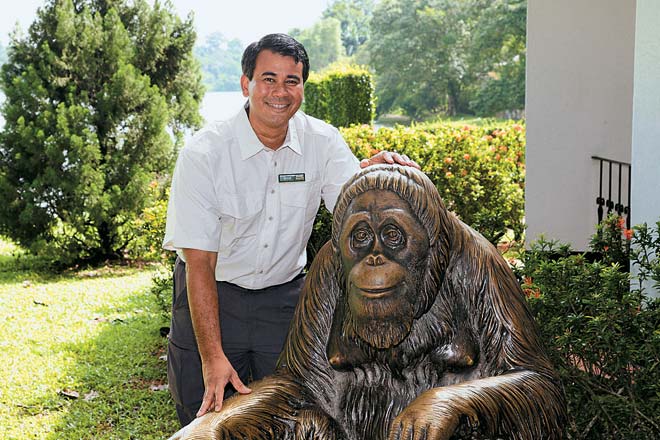OT: Your name suggests an India connection… Biswajit Guha: My father, a Bengali from Calcutta, moved to Malaysia
OT: So how did you land up at the zoo?
Biswajit Guha: I have always been interested in animals and conservation, and when I was accepted into the National University of Singapore, I decided to major in invertebrate zoology. After completing my degree, I joined the Singapore Zoo and helped establish the Fragile Forest exhibit — a walk-through rainforest habitat of mixed species like lemurs, mouse deer, sloths, tree kangaroos and invertebrates like butterflies, stick insects, millipedes and scorpions.
A pivotal experience that fired me on to do more for conservation happened several years ago, on a trip to an orangutan rehabilitation and rescue centre in Borneo. I was shocked when I was shown a female orangutan that had been caught by poachers, brought to a village, shaved, made-up and chained to a bed for commercial sexual exploitation by men working in the nearby plantations, before it was rescued.
OT: What keeps you going?
Biswajit Guha: There are many high points [to my days] — like when I’m informed of new hatchings and births, especially first-time births for certain individual animals, or first-time hatchings for various bird and reptile species. Another high point is when I walk through the parks and witness the emotional bonding between the animals, keepers and visitors. For example, one day, I was watching a pair of cotton-top tamarins venturing into their open exhibit with two babies on the father’s back. I pointed this out to a tourist, and she immediately burst into tears. I was alarmed and asked if anything was wrong — her reply was that it was one of the most beautiful and moving sights she had ever witnessed. I felt a lump in my throat, told her I agreed with her and quickly walked away.
OT: With so many species and acquisitions across the four settings — Jurong Bird Park, Singapore Zoo, Night Safari, and now the River Safari [opening this year] — have any of the animals been tricky to manage?
Biswajit Guha: One of the more memorable experiences was coordinating to bring in a pair of giraffes from Israel in 2005. They had to come in a modified container — with its roof removed — by a cargo ship on a 16-day journey. The coordination was done completely via email, faxes and phone calls, and there were numerous hair-raising moments when it appeared that the transaction wouldn’t happen. Finally the day of the giraffes’ arrival came, and we went to the wharf to see the unloading. It was amazing to see a 40ft container being hoisted up so many feet in the air and gently placed on a flatbed truck.
OT: Any favourites?
Biswajit Guha: I have a soft spot for the tamarins and marmosets, small primates from Central and South America. What they lack in size, they make up for in character. I also have a favourite animal at the Zoo and that’s Boey, the 23-year-old black-and-white ruffed lemur. He is one of the first non-domestic animals I cared for.
OT: What’s in store at the new River Safari?
Biswajit Guha: Our team selected species that were unique or synonymous with the regions featured [environments along the Mississippi, Congo, Nile, Ganges, Murray, Mekong, Yangtze and Amazon] to ensure authenticity. We also looked at other managed wildlife institutions to leverage captive management and get captive-bred and -raised animals.
Leave a Reply
You must be logged in to post a comment.


